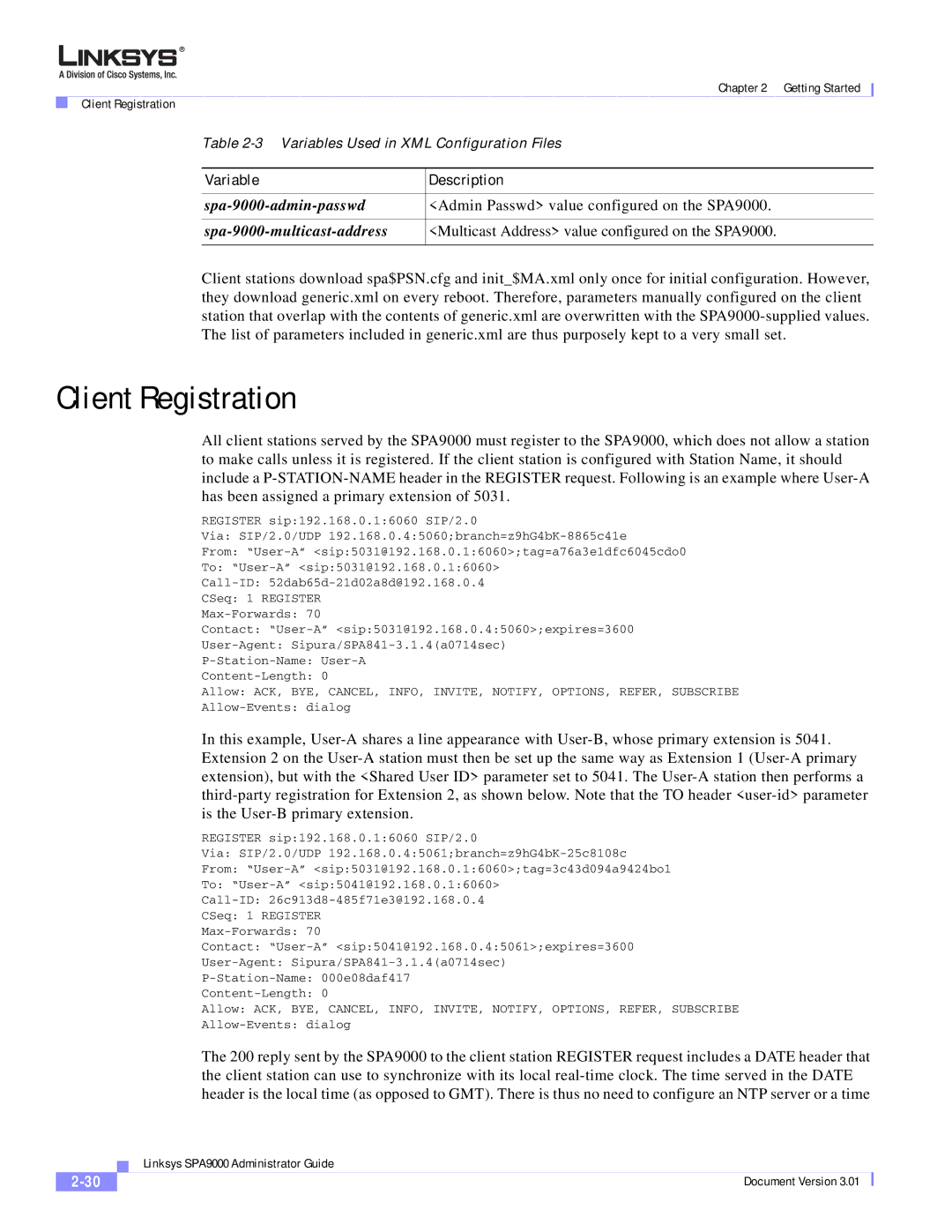Chapter 2 Getting Started
Client Registration
Table 2-3 Variables Used in XML Configuration Files
Variable | Description |
| |
spa-9000-admin-passwd | <Admin Passwd> value configured on the SPA9000. |
| |
spa-9000-multicast-address | <Multicast Address> value configured on the SPA9000. |
| |
Client stations download spa$PSN.cfg and init_$MA.xml only once for initial configuration. However, they download generic.xml on every reboot. Therefore, parameters manually configured on the client station that overlap with the contents of generic.xml are overwritten with the SPA9000-supplied values. The list of parameters included in generic.xml are thus purposely kept to a very small set.
Client Registration
All client stations served by the SPA9000 must register to the SPA9000, which does not allow a station to make calls unless it is registered. If the client station is configured with Station Name, it should include a P-STATION-NAME header in the REGISTER request. Following is an example where User-A has been assigned a primary extension of 5031.
REGISTER sip:192.168.0.1:6060 SIP/2.0
Via: SIP/2.0/UDP 192.168.0.4:5060;branch=z9hG4bK-8865c41e
From: “User-A” <sip:5031@192.168.0.1:6060>;tag=a76a3e1dfc6045cdo0
To: “User-A” <sip:5031@192.168.0.1:6060>
Call-ID: 52dab65d-21d02a8d@192.168.0.4
CSeq: 1 REGISTER
Max-Forwards: 70
Contact: “User-A” <sip:5031@192.168.0.4:5060>;expires=3600
User-Agent: Sipura/SPA841-3.1.4(a0714sec)
P-Station-Name: User-A
Content-Length: 0
Allow: ACK, BYE, CANCEL, INFO, INVITE, NOTIFY, OPTIONS, REFER, SUBSCRIBE
Allow-Events: dialog
In this example, User-A shares a line appearance with User-B, whose primary extension is 5041. Extension 2 on the User-A station must then be set up the same way as Extension 1 (User-A primary extension), but with the <Shared User ID> parameter set to 5041. The User-A station then performs a third-party registration for Extension 2, as shown below. Note that the TO header <user-id> parameter is the User-B primary extension.
REGISTER sip:192.168.0.1:6060 SIP/2.0
Via: SIP/2.0/UDP 192.168.0.4:5061;branch=z9hG4bK-25c8108c
From: “User-A” <sip:5031@192.168.0.1:6060>;tag=3c43d094a9424bo1
To: “User-A” <sip:5041@192.168.0.1:6060>
Call-ID: 26c913d8-485f71e3@192.168.0.4
CSeq: 1 REGISTER
Max-Forwards: 70
Contact: “User-A” <sip:5041@192.168.0.4:5061>;expires=3600
User-Agent: Sipura/SPA841-3.1.4(a0714sec)
P-Station-Name: 000e08daf417
Content-Length: 0
Allow: ACK, BYE, CANCEL, INFO, INVITE, NOTIFY, OPTIONS, REFER, SUBSCRIBE
Allow-Events: dialog
The 200 reply sent by the SPA9000 to the client station REGISTER request includes a DATE header that the client station can use to synchronize with its local real-time clock. The time served in the DATE header is the local time (as opposed to GMT). There is thus no need to configure an NTP server or a time
| Linksys SPA9000 Administrator Guide |
2-30 | Document Version 3.01 |

